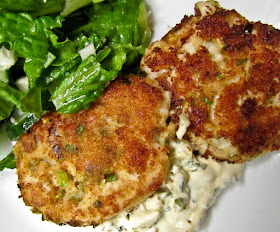I had a serious fish issue. What should I do with one more coho fillet? The galley freezer was full, we had already enjoyed BBQd salmon and iron skillet salmon this week, and the evening was too cool and wet to send the Capt outside to man the grill again. This called for something new, a flavorful recipe that would rev up our appetites for yet another salmon dinner.
Here’s another two-thumbs-up recipe for a quick salmon entrée. Quick? How quick? This dish was out of the oven and on a platter long before our old charcoal BBQ grill would have reached the white ash stage, ready to begin cooking. Now that’s quick.
All it took was a small bag of fresh vegies - a colorful mix of red, orange and yellow mini-sized sweet peppers - to point me in the right direction. OK, peppers and a quick glance at a few of my favorite seafood cookbooks for inspiration. A pile of peppers chopped into bright confetti, some capers, garlic, red onion and a basil vinaigrette all combined to create a new taste treat. The sweet pepper salsa provided a tangy contrast to the richness of the salmon. The flavors balanced nicely and oh my! it was so pretty on the plate. We’ll do this one again.
Here’s another two-thumbs-up recipe for a quick salmon entrée. Quick? How quick? This dish was out of the oven and on a platter long before our old charcoal BBQ grill would have reached the white ash stage, ready to begin cooking. Now that’s quick.
All it took was a small bag of fresh vegies - a colorful mix of red, orange and yellow mini-sized sweet peppers - to point me in the right direction. OK, peppers and a quick glance at a few of my favorite seafood cookbooks for inspiration. A pile of peppers chopped into bright confetti, some capers, garlic, red onion and a basil vinaigrette all combined to create a new taste treat. The sweet pepper salsa provided a tangy contrast to the richness of the salmon. The flavors balanced nicely and oh my! it was so pretty on the plate. We’ll do this one again.
A salmon fillet varies in thickness along its length, and this impacts cooking time. It helps to cut slices across the thick center of a fillet, and save the thinner tail end for another use. Be patient while the fish is in the oven, but check frequently for "doneness". Confession: I grew impatient after baking for 10 minutes when the fish registered barely warm in the middle. Broiling for an additional 5 minutes worked just fine for immediate consumption, but the several extra pieces were a bit dry after sitting on a platter for 10 minutes. Next time I will be more patient and will NOT use the broiler. It might help to remove the fish from the refrigerator 20 to 30 minutes beforehand to help even out the cooking time between thick centers and medium-thick pieces.
Salmon and Sweet Pepper Salsa
Serves 4
For the Salsa
2 cups fresh red, orange and yellow sweet peppers, diced
2 tablespoons capers, drained
2 tablespoons sweet onion or red onion, minced
2 cloves garlic, pressed or minced
2 tablespoons olive oil
2 tablespoons chopped basil (from a jar)
1 tablespoon red wine vinegar
Fresh basil leaves, julienned, to garnish (optional)
Lemon zest, grated, to garnish (optional)
1 salmon fillet, about 1 1/2 pounds (from the midsection, not the thin tail end), cut into 4 pieces
salt and freshly ground pepper
1. Preheat the oven to 400 F.
2. Mix the salsa ingredients together in a non-reactive bowl; set aside.
3. Sprinkle the salmon pieces with salt and pepper and place them in a baking dish that's large enough to hold them in a single layer without touching.
4. Spoon the salsa over the top of each piece.
5. Bake for 10 to 20 minutes or until barely cooked through; the fish will continue cooking after you remove it from the oven.
6. Remove the fillets to a serving platter or individual plates. Sprinkle fresh basil leaves and lemon zest on top and serve immediately.



























